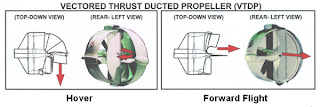New Video of the Piasecki X-49A SpeedHawk
Sad to see Mr. Piasecki go...
Sad to see Mr. Piasecki go...
Posted by
HerkEng
at
23:36
1 comments
![]()
Labels: Blackhawk, first flight, Pathfinder II, Piasecki, Piasecki 16H pathfinder I, Piasecki X-49A, PT6B-2, Speedhawk, T58-GE-8, VTDP, X-49A

Both Piasecki and Lockheed have tried something similar in the past. Lockheed doing it with it's competitor against the Hughes AH-64 Apache.  The AH-56 Cheyenne had a (un)conventional main rotor paired with wings that also provided lift, a conventional tail rotor as well as a pusher prop rotor in the rear for added speed. Top speed was around 400 km/h.
The AH-56 Cheyenne had a (un)conventional main rotor paired with wings that also provided lift, a conventional tail rotor as well as a pusher prop rotor in the rear for added speed. Top speed was around 400 km/h.  The AH-56 first flew on September 21, 1967. after a failure of one of the prototyped that lead to the death of the pilot the Army chose in favor of the AH-64.
The AH-56 first flew on September 21, 1967. after a failure of one of the prototyped that lead to the death of the pilot the Army chose in favor of the AH-64.
Piasecki also tried a similar design in the early 1960s with its Piasecki 16H Pathfinder I and Pathfinder II.  The Pathfinder I was powered by a PT6B-2 405 shp engine while the Pathfinder II was powered by a 1,250shp T58-GE-8. The Pathfinder I could reach a speed of 370 km/h.( no mention of the speed of the Pathfinder II).
The Pathfinder I was powered by a PT6B-2 405 shp engine while the Pathfinder II was powered by a 1,250shp T58-GE-8. The Pathfinder I could reach a speed of 370 km/h.( no mention of the speed of the Pathfinder II). 

On June 29, 2007 Piasecki did it again with the SpeedHawk a highly modified version of the already old UH-60 Black Hawk. 



form an "secret projects" aviation forum:
Late Friday, Piasecki Aircraft re-entered the helicopter history books with a 15 minute flight of its unique compound helicopter design, the X-49A SpeedHawk.
Lifting off at Boeing’s Rotorcraft Div., Wilmington, Del, test facility at 7.50 pm the flight test team - which had worked all week to resolve a pesky shaft vibration problem - put the aircraft through a series of turns and a short forward flight sequence.
Pilots Steve Schellburg and ‘Snake’ Jackson guided the SH-60F-based helicopter - modified with its Piasecki-designed VTDP (vectored thrust ducted propeller) tail assembly - on a maiden voyage reportedly free of any problems.
A clearly delighted company chief executive John Piasecki tells rotorhub he regards the flight as the ‘beginning of the beginning’ for the return of compound helicopter flight efficiencies to the rotorcraft industry.
Compunds promise radical increases in speed and range for conventional helicopters by off-loading rotors in favor of wingborne flight.
The Piasecki design uses a ducted propeller to provide motive thrust, as well as vectored control of direction.
‘It’s been a long, long time coming, and we’re all savoring the moment,’ he said.
The team is utilising Boeing flight test telemetry facilities at Wilmington once used for V-22 testing, and - as reported in rotorhub last week - the latter is co-operating on the program because of potential interest in the VTDP design for future applications.
Piasecki has just signed a $3.1-million development contract with the Army’s AATD (Aviation Applied Technology Directorate) organisation in Ft. Eustis, Va., one of the more a forward-looking agencies often associated with pushing rotorcraft technology boundaries.
Piasecki says a 100-hour flight test program now lies ahead.
‘The schedule is still fluid but we anticipate being able to get this done within the rest of the year.’ The program will receive incremental funding as it progresses, he said.
The success of the first flight has enormous potential significance for a technology that many have often derided as impractical.
The Piasecki organisation stuck to its guns, however, working the problem resolutely for many, many years, drawing on bursts of funding enthusiasm mostly from within the Navy, the US Marine Corps and the Army.
‘A lot of people said this day would never come,’ Piasecki said. ‘Well, they were wrong.’
* A personal loss - the sudden death last week of Carl, USMC sergeant son of Terry Crews a well regarded figure in the helicopter industry - motivated the flight to be dedicated to him, Piasecki said.
Posted by
HerkEng
at
08:08
5
comments
![]()
Labels: AATD Aviation Applied Technology Directorate, AH-56A Cheyenne, AH-64 Apache, first flight, Pathfinder II, Piasecki, Piasecki 16H pathfinder I, Piasecki X-49A, PT6B-2, Speedhawk, T58-GE-8, V-22, VTDP
